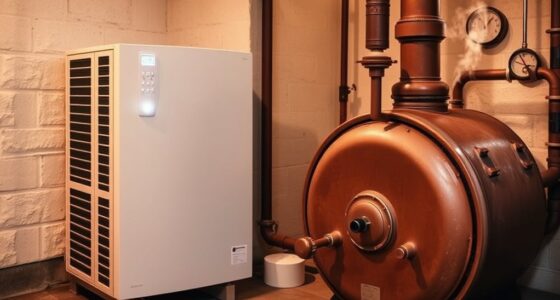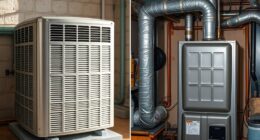Heat pump adoption is gaining momentum worldwide, driven by the need for energy efficiency and sustainability. Countries like Japan, Nordic nations, and those in Europe are leading the charge, with record installation numbers reflecting a strong shift towards decarbonization. You'll find that misconceptions about heat pumps, like their effectiveness in cold climates, are being dispelled as advanced models prove their efficiency. Government incentives are encouraging homeowners and businesses to invest, overcoming initial cost barriers. If you're curious about specific case studies and strategies that support this trend, there's more to discover.
Key Takeaways
- Heat pump adoption is vital for decarbonizing buildings and meeting global sustainability goals, with significant growth observed globally, especially in Europe and the U.S.
- Countries like Japan and Nordic nations lead in heat pump installations, driven by regulatory support and government incentives.
- Advanced heat pump technology achieves energy efficiencies exceeding 400%, effectively cooling and heating spaces even in extreme cold conditions.
- Misconceptions about heat pumps, such as their effectiveness in cold climates and installation costs, hinder adoption but can be addressed through education.
- Engaging Indigenous communities and incorporating their perspectives can enhance acceptance of heat pump technology and promote inclusive energy policies.
Global Sustainability Goals
Achieving sustainability is more than just a goal; it's a necessity for our planet's future. You mightn't realize it, but heat pump adoption plays an essential role in decarbonizing our buildings and meeting global sustainability goals.
By integrating renewable energy sources, heat pumps can considerably reduce greenhouse gas emissions compared to traditional fossil fuel heating methods. Additionally, utilizing geothermal energy generation in conjunction with heat pumps can further enhance energy efficiency and reliability.
Countries like Japan and Nordic nations demonstrate how effective heat pump systems can be when integrated into housing sectors. Their high adoption rates highlight the importance of energy efficiency in achieving net zero emissions. You can also contribute to this movement by considering heat pumps for your own home or encouraging local initiatives.
The Building Decarbonization Alliance emphasizes the need for regulatory interventions that promote heat pump adoption, supporting the shift towards all-electric buildings. Government incentives and rebates can make these systems more accessible, driving further adoption.
Heat Pump Technology Overview

Heat pumps are innovative systems that efficiently heat and cool your space by transferring heat with a compressor. They utilize refrigerant to absorb and release thermal energy, making them highly effective in various climates.
You've got two main types to choose from: air source and ground source, each offering unique benefits.
With impressive energy efficiency, these systems can save you a significant amount on your energy bills while meeting local energy codes, especially when considering thermal energy transfer basics.
Heat Pump Functionality Explained
One key innovation in modern climate control is the heat pump, which effectively transfers heat from one location to another. This versatile heat pump system can heat and cool spaces depending on the season, making it an ideal choice for year-round comfort. It operates using a compressor and a reversing valve, allowing it to switch between heating in winter and cooling in summer.
Heat pumps come in two main types: air source and ground source (geothermal). In cold climates, advanced models can achieve energy efficiency ratings exceeding 400%, remarkably outperforming traditional heating systems. This energy-efficient technology not only reduces greenhouse gas emissions but also brings economic benefits through lower energy bills.
Here's a quick comparison of heat pump types:
| Type | Heat Source | Efficiency Rating |
|---|---|---|
| Air Source Heat Pumps | Air | Up to 400% |
| Ground Source Heat Pumps | Ground/Water | Up to 600% |
| Reversible Systems | Air (Heating/Cooling) | Seasonal Efficiency |
| Economic Benefits | Lower energy costs | Reduced emissions |
Types of Heat Pumps
While many people may be familiar with heat pumps, understanding the different types can help you choose the right system for your needs. Here's a quick overview of the two main types of heat pumps:
– Air Source Heat Pumps: These extract heat from the air and can operate in temperatures as low as -15°C (5°F), making them versatile for various climates.
They're particularly useful in regions where energy efficiency is a priority, similar to the diversification benefits of a Gold IRA for financial portfolios.
– Ground Source Heat Pumps: Also known as geothermal systems, these draw heat from the ground or water sources.
While they require more extensive installation due to buried piping, they offer higher efficiency and lower operating costs over time. Their long-term reliability can be compared to the appreciation potential of gold investments.
– Reversible Functionality: Both types utilize a reversing valve, allowing them to function as heaters in the winter and air conditioners in the summer.
The adoption of heat pumps is rapidly increasing worldwide, with Europe leading the way, having installed a record 3 million heat pumps in 2022.
This trend reflects the growing awareness of their benefits and the need for efficient heating and cooling solutions.
Energy Efficiency Benefits
If you're looking for an effective way to reduce energy consumption in your home, heat pumps stand out as a leading solution. These systems can achieve energy efficiencies exceeding 400%, meaning they produce more energy than they consume. This efficiency is especially impressive in cold climates, where models operate effectively at temperatures as low as -15°C (5°F).
As the demand for sustainable solutions grows, there's also a rising need for professionals who can help implement these technologies effectively, similar to the growing demand for AI ethicists in tech who shape ethical guidelines for emerging technologies.
By installing heat pumps, you can considerably cut your energy usage compared to traditional fossil fuel heating systems. This not only lowers your energy bills but also helps reduce greenhouse gas emissions, contributing to a more sustainable future.
In fact, the U.S. has seen an 18% increase in ducted heat pump sales from 2018 to 2022, showcasing the growing recognition of their energy efficiency benefits.
Additionally, heat pumps enhance indoor air quality through improved ventilation, an essential aspect of energy-efficient building design.
In Europe, heat pump installations reached a record high of 3 million in 2022, reflecting their role in achieving energy efficiency goals.
With the added advantage of demand response capabilities, adopting heat pumps is a smart choice for both your home and the planet.
Addressing Common Misconceptions

When considering heat pumps, many misconceptions can cloud your judgment about their effectiveness and practicality. To help clear things up, here are a few common myths:
- Heat pumps are ineffective in cold climates.
- They're only suitable for single-family homes.
- Installation costs are prohibitive and not worth it.
In reality, specialized heat pumps exist that maintain efficiency even at -15°C (5°F). They work exceptionally well in all types of buildings, including multi-family housing and commercial spaces.
Additionally, understanding the unique needs of different environments, much like knowing the nutritional needs of dogs, can help in making informed decisions. While initial costs might be higher, the long-term energy savings make them a smart investment.
Another misconception is that heat pumps require extensive ductwork. Ductless options are available, making it easy to retrofit older buildings without existing systems.
Education on heat pump technology is crucial to dispel these myths, as a lack of awareness prevents wider adoption of these efficient systems.
Market Trends and Adoption Rates

As you explore the market trends and adoption rates of heat pumps, you'll notice significant growth in installations worldwide.
This surge is partly driven by the demand for energy-efficient home solutions, with many homeowners opting for technologies that enhance comfort while reducing energy costs.
Europe leads the charge with record numbers, while regions like Poland show rapid adoption rates that highlight regional differences.
Understanding these trends will help you appreciate how heat pump technology is reshaping the energy landscape globally.
Global Installation Growth
Heat pump adoption is skyrocketing worldwide, reflecting a major change in how we think about heating and cooling our homes. As countries aim for net zero emissions, heat pumps are becoming a key player in the energy transformation.
Recent insights suggest that incorporating energy-efficient technologies can greatly enhance overall energy savings. Here are some trends you should know:
- In 2022, Europe installed a record 3 million heat pumps, a nearly 40% increase from the prior year.
- Nordic countries lead the way, achieving notable penetration rates per 1,000 households.
- The U.S. market is catching up, with heat pump sales now matching traditional furnace sales, signaling a shift towards decarbonization.
Poland's remarkable 140% growth in heat pump installations shows how quickly adoption is rising across Europe.
Additionally, ducted heat pump sales in North America increased by 18% from 2018 to 2022, highlighting growing acceptance in residential and commercial buildings.
This surge isn't just about technology; it's about transforming our approach to energy use. As you consider your heating and cooling options, remember that choosing a heat pump is a step towards a more sustainable future.
Regional Adoption Differences
Across the globe, adoption rates for heat pumps vary considerably, reflecting each region's unique climate, energy policies, and consumer preferences. In 2022, European countries showcased a strong commitment to heat pump installations, reaching a record high of 3 million units—an almost 40% increase from the previous year. This significant growth aligns with the trend of importance of metrics in understanding consumer behavior and optimizing marketing strategies.
Nordic nations lead the way, benefiting from their colder climates and higher heating demands, which drive significant market penetration.
Meanwhile, China dominated global sales, emphasizing its focus on energy efficiency and decarbonization initiatives. In North America, particularly the U.S., the heat pump market is growing, with ducted heat pump sales increasing by 18% from 2018 to 2022. This suggests a rising awareness of the advantages heat pumps offer over traditional heating systems.
Notably, Poland experienced a remarkable 140% growth in heat pump installations, a clear sign of a shift toward energy-efficient solutions driven by supportive regulations and consumer demand.
As you explore these regional differences, it's evident that understanding local contexts is essential for driving heat pump adoption and achieving energy efficiency goals worldwide.
Installation Challenges and Solutions

While many homeowners are keen to adopt heat pump technology, several installation challenges can hinder the process. Understanding these challenges can help you make informed decisions and guarantee your HVAC system operates efficiently.
Additionally, the mental health of homeowners can play a role in their decision-making process, as stress from potential high costs or installation complications may lead to anxiety. Emotional support during the grieving process is essential for caregivers when maneuvering such changes in home comfort.
- Higher Initial Costs: The upfront installation costs for heat pumps can be greater than traditional systems, but government incentives can help alleviate this burden.
- Proper Sizing: Confirming your heat pump is the right size is essential. Improper installations can lead to inefficiencies, increasing energy costs.
- Retrofitting Needs: Modifications to your ductwork or opting for ductless systems may be necessary if you're retrofitting an existing home.
In colder climates, advanced heat pump models can function reliably at temperatures as low as 5°F (-15°C), dispelling myths about their inefficiency.
Additionally, local climate conditions greatly affect which heat pump system is best suited for your home, especially for ground-source systems that require ample land and specific feasibility assessments.
Community and Indigenous Engagement

Recognizing the importance of community and Indigenous engagement can greatly enhance the adoption of heat pump technology. When you engage Indigenous communities in discussions about heat pumps, you open doors to awareness and understanding of their benefits. This dialogue promotes sustainable practices that align with traditional ecological knowledge, which is invaluable for creating effective energy initiatives.
Studies have shown that astrology and attractiveness can influence how communities perceive new technologies, potentially impacting their acceptance and integration.
Acknowledge the traditional territories of Indigenous peoples to foster respectful relationships and collaboration. By integrating Indigenous perspectives into your energy initiatives, you can develop more inclusive policies and programs that respect cultural values and land stewardship. This approach not only honors Indigenous wisdom but also enriches the overall community engagement process.
Moreover, community engagement strategies that actively involve Indigenous voices can facilitate greater acceptance of heat pump technology among diverse populations. The HVAC 2.0 Program highlights the need for improved business models for HVAC contractors, which can lead to better client satisfaction.
Frequently Asked Questions
What Is the Trend in the Heat Pump Market?
You'll notice a growing trend in the heat pump market, with significant increases in installations across Europe, the U.S., and China. More homeowners recognize their benefits, driving demand for efficient heating and cooling solutions.
Which Countries Use Heat Pumps the Most?
Countries like Japan, China, and Nordic nations lead in heat pump usage. In Japan, almost all multifamily homes have them. You'll also find significant growth in Poland and increasing adoption in the U.S. market.
What Is the Future of Heat Pump Technology?
The future of heat pump technology looks promising. You'll see innovative designs, improved efficiency, and increased adoption as more people recognize the benefits. Embracing these advancements will help you achieve sustainable energy solutions for your home.
What Is the Adoption Rate for Heat Pumps?
The adoption rate for heat pumps is rising steadily. In the U.S., ducted heat pump sales increased by 18% since 2018, while Europe installed a record 3 million units in 2022, showcasing their growing popularity.
Conclusion
In embracing heat pump technology, you're stepping into a world of sustainability that not only meets global goals but also enriches your community. While there may be a few bumps along the way, the journey towards cleaner energy is worth every effort. By addressing misconceptions and overcoming challenges together, you're not just adopting a solution; you're fostering a brighter, greener future for everyone. So, let's celebrate the progress and keep the momentum going!









